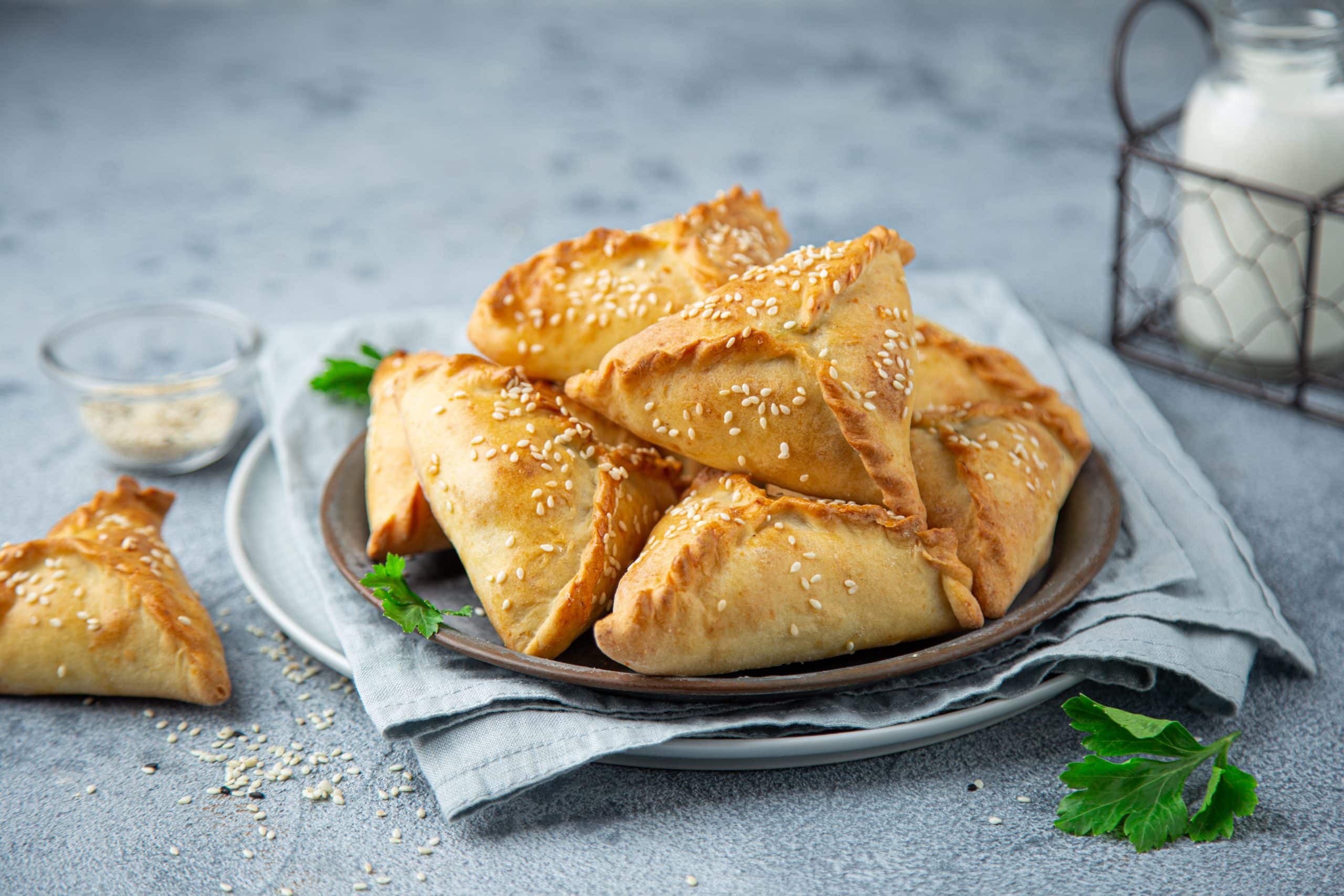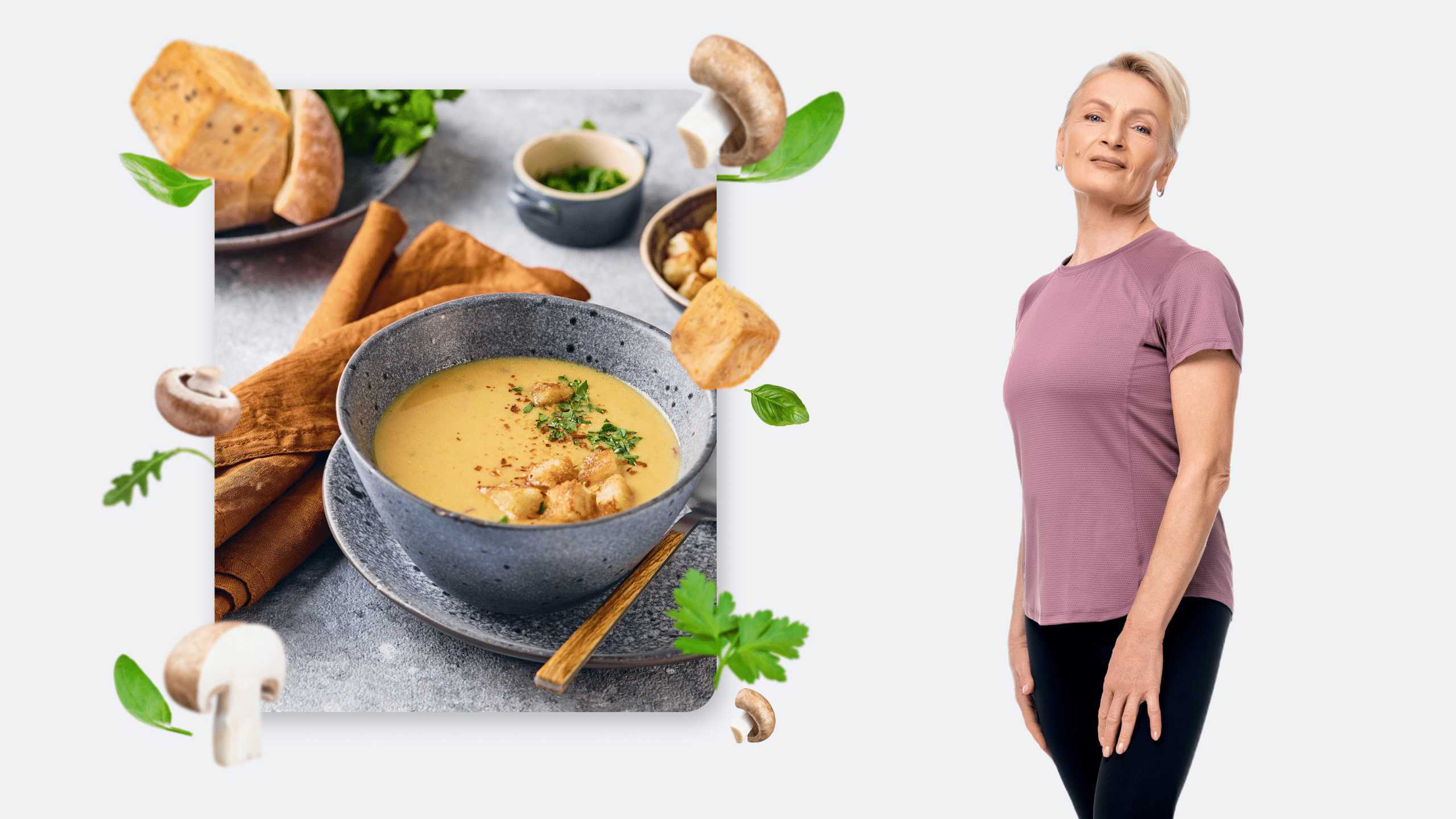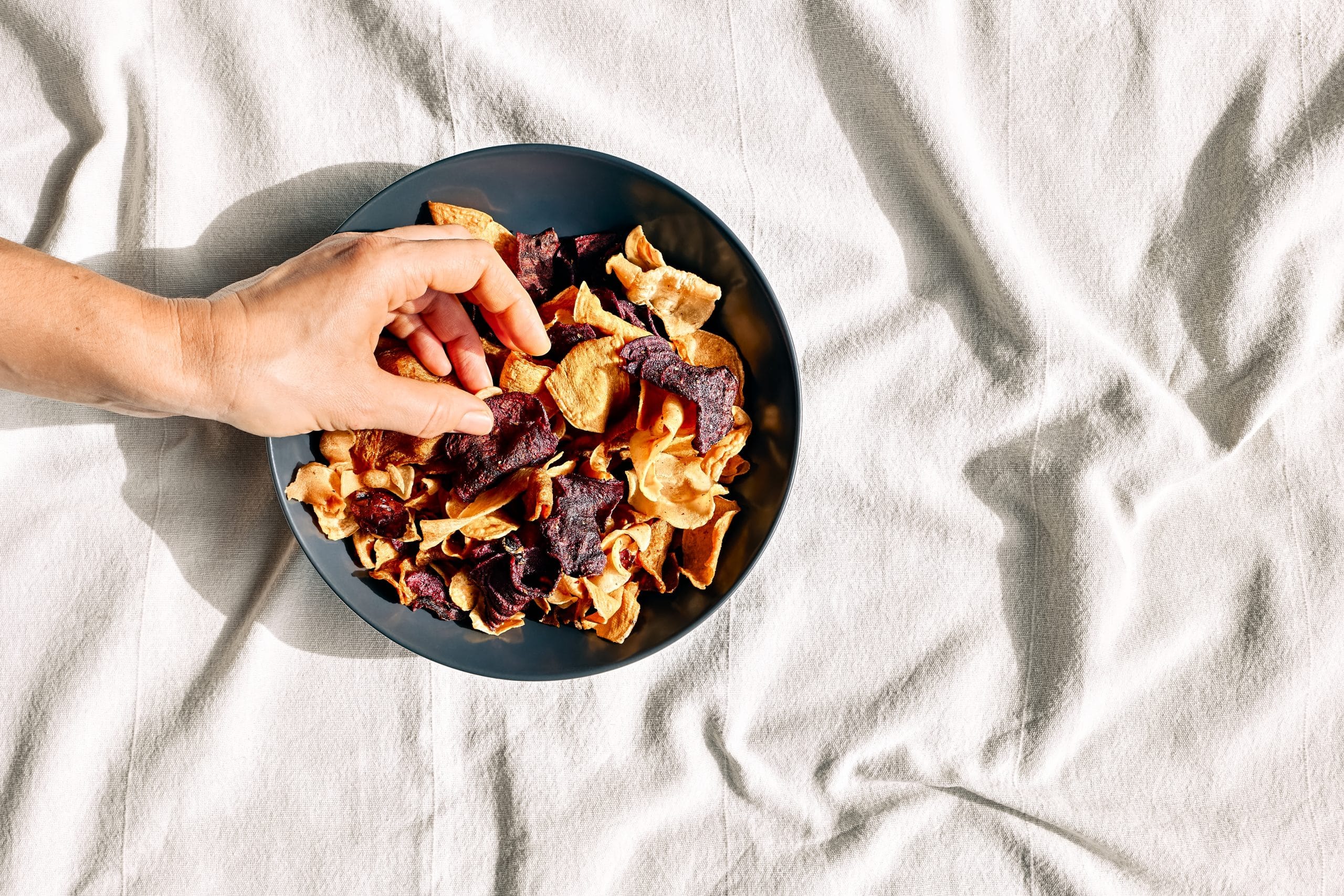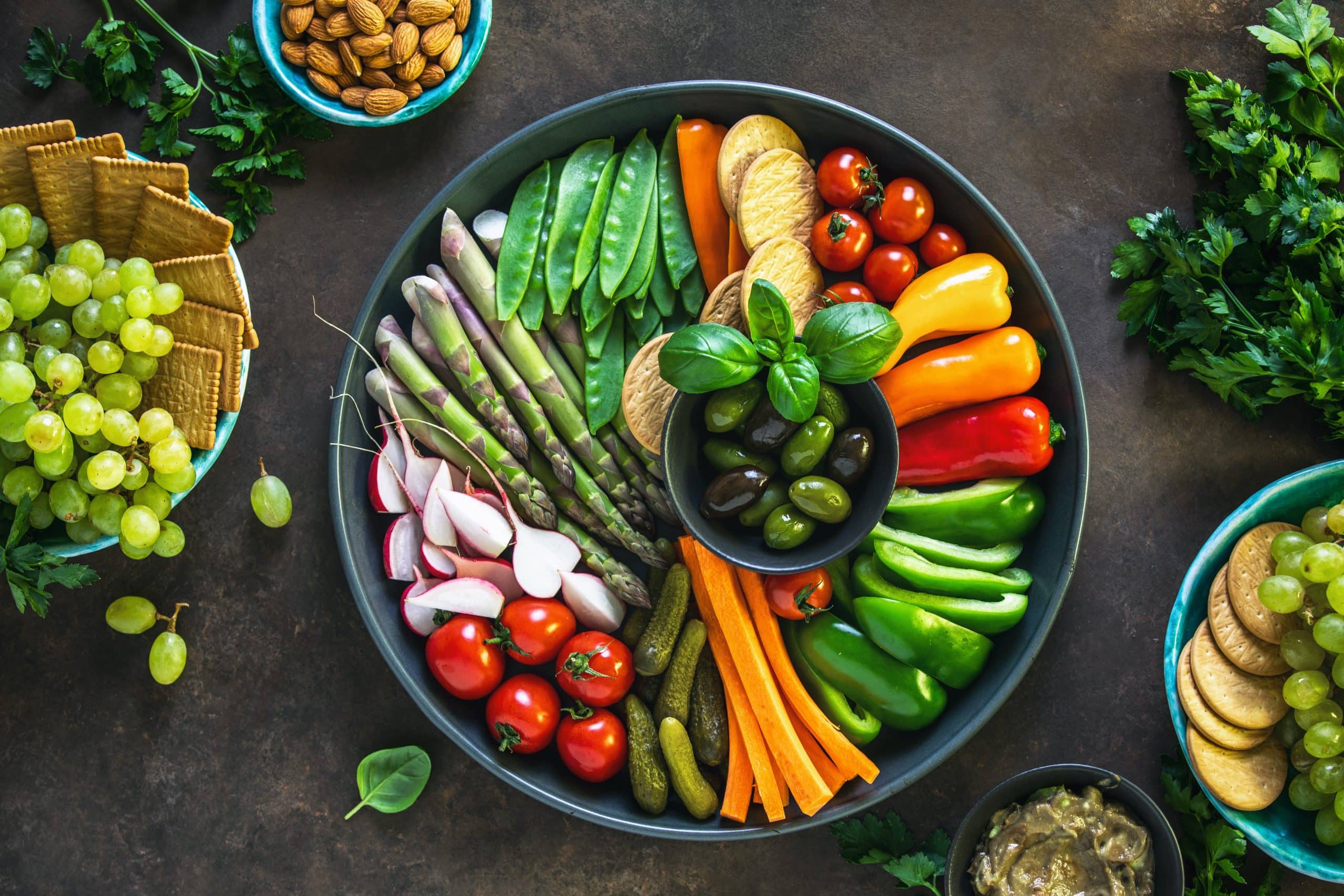The samosa is arguably one of the world’s most beloved vegan snacks. It may be from India, the bustling food stalls of East Africa, or even from the fusion kitchens of the West.
One thing remains universally true: when cooked right, a samosa’s flaky crust and richly spiced filling can transcend cultural boundaries and become a global culinary delight.
That said, today we’ll get into the nitty-gritty of creating the crispiest, most flavorful vegan samosa. From the technique of folding that iconic triangular pastry, to the art of infusing the right balance of spices in the hearty vegetable filling, and even the secret to a tangy tamarind chutney for that perfect dip.
Are Vegetable Samosas Suitable for Vegans?
Vegetable samosas are suitable for vegans, as they don’t typically include any animal products.
Traditionally, veggie samosas are made with a spiced potato and pea filling. However, there are endless variations and possibilities when it comes to this versatile snack.
You can use a combination of vegetables such as carrots, cauliflower, sweet potatoes, or even lentils for a protein-packed option. Just make sure to avoid using any animal-based products such as ghee or butter in the cooking process.
BetterMe App helps you achieve your body goals with ease and efficiency by helping to choose proper meal plans and effective workouts. Start using our app and you will see good results in a short time.
Can Vegans Eat Fried Foods?
Yes, vegans can eat fried foods, as long as they are prepared without any animal products. In this vegan samosa recipe we’ll be using vegetable oil for frying instead of ghee or butter.
However, the healthiness of fried foods is a debated topic. While it’s true that deep frying can add unwanted calories and fats, there are ways to make it healthier, and everything can be included in moderation.
For example, using high-quality oil with a high smoke point and not overcrowding the pot to maintain proper frying temperatures can result in less greasy and more nutritious fried food.
Are Vegetable Samosas Healthy?
It depends on how they are prepared. Deep-fried samosas can be high in calories and unhealthy fats, but baked or air-fried versions can be a lighter option.
Despite how they’re cooked, samosas contain a variety of vegetables and spices that have nutritional benefits. For example, potatoes are a good source of potassium, peas are rich in fiber and protein, and spices like turmeric have anti-inflammatory properties.
Plus, by making your own samosas at home you have control over the ingredients used and can make adjustments according to your dietary needs.
What Is Vegetable Samosa Made Of?
Vegetable samosa is made of two parts; a crispy outer pastry and a flavorful filling.
The outer pastry is typically made of wheat flour, water, and oil. It’s rolled out thin and cut into triangles for the classic samosa shape.
In some recipes, filo dough or wonton wrappers can also be used as a shortcut. Filo dough is a flaky and buttery pastry commonly used in Mediterranean and Middle Eastern cuisines, while wonton wrappers are thin sheets of dough often used for dumplings in Chinese cuisine.
However, for the crispiest and most flavorful samosas, making your own pastry from scratch is recommended.
The filling is where the real magic happens. It can be made of various combinations of vegetables, spices, and even proteins like tofu or beans. The key is to have a balance of flavors and textures in the filling to complement the crispy pastry shell.
Here are some common ingredients used in vegan samosa fillings:
- Potatoes – Punjabi and Gujarati versions of samosas often use potatoes as the main ingredient.
- Peas – A traditional addition to potato samosas, peas add a touch of sweetness and texture to the filling.
- Carrots – Adding carrots not only adds color but also provides a natural sweetness and crunch.
- Cauliflower – This versatile vegetable can provide a meaty texture to the filling when chopped small or grated.
- Sweet potatoes – An excellent source of vitamins and minerals, sweet potatoes give a creamy texture to the filling.
- Spinach – A common ingredient in Indian samosas, spinach adds a vibrant color and earthy flavor.
- Onion – Sautéed onions add depth and sweetness to the filling.
- Garlic – For a bold and aromatic addition, sautéed garlic can elevate the flavors in the filling.
- Ginger – Fresh ginger adds a spicy and slightly sweet kick to the filling.
- Cilantro – Adding fresh herbs like cilantro can add a pop of freshness to the filling. Other herbs commonly used include mint, parsley, or dill.
- Green chilies – To add some heat, green chilies can be added to the filling.
- Cumin – Ground cumin is a staple spice in Indian cuisine and adds an earthy and nutty flavor to the filling.
- Coriander seeds – These tiny seeds are full of flavor and add a citrusy and slightly floral note to the filling.
- Garam masala – A blend of various spices, garam masala adds warmth and complexity to the filling.
- Turmeric – This golden spice is known for its anti-inflammatory properties and adds a vibrant color to the filling (2).
- Cinnamon – A pinch of ground cinnamon can add a hint of sweetness and warmth to the filling.
- Nutmeg – Another warm spice, nutmeg has a sweet and slightly nutty flavor that pairs well with the other spices in the filling.
- Black pepper – A staple spice in any kitchen, black pepper adds a bit of heat and depth to the filling.
- Salt – A dash of salt is essential for balancing out the flavors in the filling.
- Lemon juice – A squeeze of fresh lemon juice can add a bright and tangy note to the filling.
Read more: Steamed dumplings: One Recipe That’ll Change Your Snack Game
Vegan Samosa Recipe Easy (3)
The best vegan samosa recipe is one that you can easily make at home with readily available ingredients. Using store- bought pastry dough is one way to make this recipe easier.
Ingredients
- 3 tbsp oil
- 1 tsp cumin seeds
- 1 1/2 cups diced onions
- 3 cups diced potatoes
- 1/2 cup diced carrots
- 1/8 tsp ground turmeric
- salt
- 2–3 green chillies (adjust to taste)
- 3/4 cup tinned sweetcorn
- 1/2 cup frozen peas
- 1–2 tsp brown sugar
- 1/4 tsp ground cinnamon
- 1/8 tsp ground clove
- 1/4 tsp citric acid (add another 1/8 tsp if needed)
Other
- 24–26 sheets of samosa pastry
- oil for frying
- 2 tbsp flour
- 3 tbsp water
Instructions
- Start by heating 3 tablespoons of oil in a large pan over medium heat.
- When the oil is hot, add 1 teaspoon of cumin seeds and let them sizzle.
- Once the cumin seeds begin to sizzle, add 1 1/2 cups of diced onions to the pan. Stir well and let the onions turn translucent.
- Now, add 3 cups of diced potatoes and 1/2 cup of diced carrots to the pan. Stir to combine.
- Sprinkle 1/8 teaspoon of ground turmeric and salt to taste over the vegetables and toss well to evenly distribute.
- Add 2-3 green chillies (adjust according to your taste), 3/4 cup of tinned sweetcorn, and 1/2 cup of frozen peas to the pan, stirring well.
- Sprinkle 1-2 teaspoons of brown sugar, 1/4 teaspoon of ground cinnamon, and 1/8 teaspoon of ground clove over the vegetables. Stir well.
- Add 1/4 teaspoon of citric acid to the pan and stir. Taste and add an additional 1/8 teaspoon of citric acid if needed.
- Cover the pan and let the filling cook over low heat until the potatoes and carrots are soft.
- While the filling is cooking, prepare a sticky paste by mixing 2 tablespoons of flour with 3 tablespoons of water.
- Once the filling is cooked, let it cool down slightly. Meanwhile, separate the samosa pastry sheets.
- Take one pastry sheet at a time and fold it into a cone shape. Fill it with a spoonful of the prepared vegetable filling.
- Use the flour-water paste to seal the edges of the pastry, ensuring it is tightly closed.
- Repeat the filling and sealing process with all the pastry sheets.
- Finally, heat oil in a deep pan and deep fry the samosas until they turn a lovely golden brown color. Make sure the heat is medium to ensure even cooking.
- Once done, remove the samosas from the oil and drain excess oil by placing them on a paper towel.
- Serve hot with your choice of dipping sauce or chutney.
Nutrition
Calories: 371
Recipe yields 24 samosas.
To turn this into a baked vegan samosa recipe, simply follow all the steps until filling and sealing the samosas.
Instead of deep frying them, preheat your oven to 400°F (200°C). Place the sealed samosas on a baking sheet lined with parchment paper, brush them with a little oil, and bake for 20-25 minutes until crispy and golden brown.
If you wish to free yourself from all the extra pounds that have been weighting you down for way too long, start using the BetterMe app and overhaul your entire life!
Vegan Samosa Recipe with Filo Pastry(1)
Filo pastry is a healthier alternative to traditional samosa pastry as it contains less oil. Here’s an easy vegan samosa recipe using filo pastry:
Ingredients
- 1 tablespoon sunflower oil
- 1 small onion finely chopped
- 2 cloves garlic finely chopped
- 1 small piece ginger finely chopped
- ¼ teaspoon ground coriander
- ¼ teaspoon ground cumin
- 1 teaspoon garam masala
- ½ teaspoon ground chilli powder optional
- 2 small potatoes diced
- 1 carrot diced
- 2 tablespoon water
- handful frozen peas
- Salt and pepper to taste optional
- 4 large sheets of filo pastry
- Sunflower oil for brushing
Instructions
To make the filling:
- Heat 1 tablespoon of sunflower oil in a pan, add the onions and cook until softened.
- Add the garlic, ginger, coriander, cumin, garam masala and chili powder (if using) to the pan, stir well.
- Once fragrant, add the diced potatoes and carrots to the pan along with 2 tablespoons of water.
- Cover and cook until the vegetables are soft, stirring occasionally to prevent sticking.
- Once cooked, add a handful of frozen peas and season with salt and pepper (if desired). Let it cool down slightly before using as filling.
To cook the samosas:
- Preheat your oven to 375°F (190°C).
- Lay out one sheet of filo pastry and brush it with a little oil.
- Place another sheet on top and cut it lengthwise into two equal strips.
- Add a spoonful of the filling onto the bottom corner of each strip, leaving some space around the edges.
- Fold the bottom corner over the filling to make a triangle, then continue folding up until you reach the end of the strip.
- Repeat with the remaining pastry sheets and filling.
- Place the samosas onto a baking sheet lined with parchment paper and brush them with oil.
- Bake for 12-15 minutes until golden brown and crispy.
- Serve hot with your favorite dipping sauce or chutney.
Nutrition per serving (recipe yields 8)
Calories: 104 kcal | Carbohydrates: 19g | Protein: 3g | Fat: 2g | Saturated Fat: 1g | Polyunsaturated Fat: 1g | Monounsaturated Fat: 2g | Sodium: 12mg | Potassium: 280mg | Fiber: 2g | Sugar: 2g | Vitamin A: 1314IU | Vitamin C: 12mg | Calcium: 15mg | Iron: 1mg
Read more: Vegan Tempura Recipe: How To Make a Crunchy, Plant-Based Snack
FAQs
Are Veggie Stock Cubes Vegan?
Most, but not all veggie stock cubes are vegan, as some may contain dairy or other animal-derived ingredients. For example, some may contain milk powder or chicken fat.
Check the ingredients before purchasing; names like lactose or whey can indicate the presence of dairy. Alternatively, you can make your own vegan stock at home by boiling vegetables, herbs, and spices in water for a flavorful base.
Is Veggie Meat Vegan?
Veggie meat or mock meat can vary in its ingredients and may or may not be vegan. Some veggie meats are made with plant-based protein sources like tofu, tempeh, or seitan and are suitable for a vegan diet. However, others may contain dairy or egg products as binders or flavorings.
Can Vegans Have Gravy?
Yes, vegans can have gravy as long as it is made without any animal products. Instead of using meat drippings or broth, you can use vegetable stock or mushroom broth for a delicious vegan gravy. You can also make a flavorful gravy using ingredients like onions, garlic, herbs, and flour.
What Are The Best Vegan Spicy Foods?
The best vegan spicy foods are those that use plant-based ingredients to achieve delicious and fiery flavors. Some popular options include spicy curries, tacos filled with spiced beans or tofu, hot sauces made with chili peppers, and dishes featuring fermented foods like kimchi or sriracha. You can also add heat to your meals by using spices like cayenne pepper, paprika, or red pepper flakes.
The Bottom Line
The right vegan samosa recipe can be a delicious and satisfying addition to your plant-based diet. Whether you choose to bake or fry them, these savory pastries filled with flavorful vegetables are sure to be a hit. Experiment with different spices and veggies to find your favorite combination, and don’t forget the dipping sauce.
DISCLAIMER:
This article is intended for general informational purposes only and does not serve to address individual circumstances. It is not a substitute for professional advice or help and should not be relied on for making any kind of decision-making. Any action taken as a direct or indirect result of the information in this article is entirely at your own risk and is your sole responsibility.
BetterMe, its content staff, and its medical advisors accept no responsibility for inaccuracies, errors, misstatements, inconsistencies, or omissions and specifically disclaim any liability, loss or risk, personal, professional or otherwise, which may be incurred as a consequence, directly or indirectly, of the use and/or application of any content.
You should always seek the advice of your physician or other qualified health provider with any questions you may have regarding a medical condition or your specific situation. Never disregard professional medical advice or delay seeking it because of BetterMe content. If you suspect or think you may have a medical emergency, call your doctor.
SOURCES:
- EASY VEGETABLE SAMOSA RECIPE | VEGAN (2019,sneakyveg.com)
- Turmeric, the Golden Spice (2011,nih.gov)
- Vegetable Samosas (2022,cookingwithparita.com)











